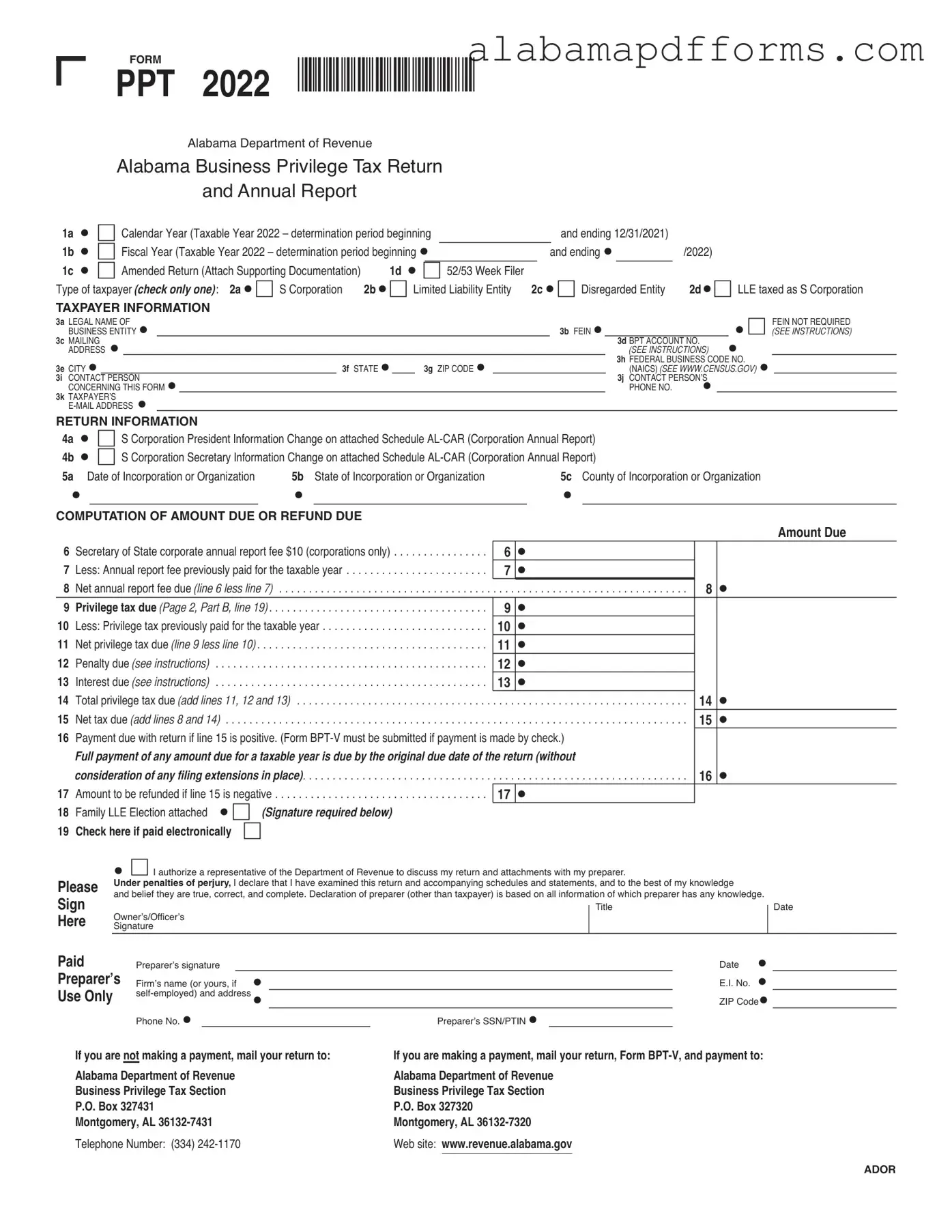
FORM
PPT 2022 *220001PP*
Alabama Department of Revenue
Alabama Business Privilege Tax Return
and Annual Report
1a |
6 Calendar Year (Taxable Year 2022 – determination period beginning |
and ending 12/31/2021) |
|
1b |
6 Fiscal Year (Taxable Year 2022 – determination period beginning |
|
and ending |
/2022) |
1c |
6 Amended Return (Attach Supporting Documentation) |
1d |
6 52/53 Week Filer |
|
|
Type of taxpayer (check only one): 2a |
6 S Corporation |
2b |
6 Limited Liability Entity |
2c 6 Disregarded Entity |
2d |
6 LLE taxed as S Corporation |
TAXPAYER INFORMATION |
|
|
|
|
|
|
|
|
3a LEGAL NAME OF |
|
|
|
|
|
|
6 |
FEIN NOT REQUIRED |
BUSINESS ENTITY |
|
|
|
|
3b FEIN |
|
(SEE INSTRUCTIONS) |
3c MAILING |
|
|
|
|
3d BPT ACCOUNT NO. |
|
|
ADDRESS |
|
|
|
|
(SEE INSTRUCTIONS) |
|
|
|
|
|
|
|
|
3h FEDERAL BUSINESS CODE NO. |
|
3e CITY |
3f |
STATE |
3g ZIP CODE |
|
(NAICS) (SEE WWW.CENSUS.GOV) |
|
3i CONTACT PERSON |
|
|
|
|
3j CONTACT PERSON’S |
|
|
CONCERNING THIS FORM |
|
|
|
|
PHONE NO. |
|
|
|
3k TAXPAYER’S |
|
|
|
|
|
|
|
|
E-MAIL ADDRESS |
|
|
|
|
|
|
|
|
RETURN INFORMATION |
|
|
|
|
|
|
|
|
4a |
6 S Corporation President Information Change on attached Schedule AL-CAR (Corporation Annual Report) |
|
|
|
4b |
6 S Corporation Secretary Information Change on attached Schedule AL-CAR (Corporation Annual Report) |
|
|
|
5a |
Date of Incorporation or Organization |
5b State of Incorporation or Organization |
|
5c County of Incorporation or Organization |
|
COMPUTATION OF AMOUNT DUE OR REFUND DUE |
|
|
|
|
|
|
|
|
|
|
|
|
|
|
|
Amount Due |
6 Secretary of State corporate annual report fee $10 (corporations only) |
6 |
|
|
|
|
7 Less: Annual report fee previously paid for the taxable year . |
. . . . . . |
. . . . . . . . . . . . . . . . . |
7 |
|
|
|
|
8 Net annual report fee due (line 6 less line 7) |
. . . . . . |
. . . . . . . . . . . . . . . . . . . |
. . . . . |
. . . . . . . . . . . . . . . . . . . . . . . . . . . |
8 |
|
|
9 |
Privilege tax due (Page 2, Part B, line 19) |
. . . . . . |
. . . . . . . . . . . . . . . . . |
9 |
|
|
|
|
10 |
Less: Privilege tax previously paid for the taxable year |
. . . . . . |
. . . . . . . . . . . . . . . . . |
10 |
|
|
|
|
11 |
Net privilege tax due (line 9 less line 10) |
. . . . . . |
. . . . . . . . . . . . . . . . . |
11 |
|
|
|
|
12 |
Penalty due (see instructions) |
. . . . . . . . . . . . . . . . |
. . . . . . |
. . . . . . . . . . . . . . . . . |
12 |
|
|
|
|
13 |
Interest due (see instructions) |
. . . . . . . . . . . . . . . . |
. . . . . . |
. . . . . . . . . . . . . . . . . |
13 |
|
|
|
|
14 |
Total privilege tax due (add lines 11, 12 and 13) |
. . . . . . |
. . . . . . . . . . . . . . . . . . . |
. . . . . |
. . . . . . . . . . . . . . . . . . . . . . . . . . . |
14 |
|
|
15 |
Net tax due (add lines 8 and 14) |
. . . . . . . . . . . . . . . . |
. . . . . . |
. . . . . . . . . . . . . . . . . . . |
. . . . . |
. . . . . . . . . . . . . . . . . . . . . . . . . . . |
15 |
|
|
16Payment due with return if line 15 is positive. (Form BPT-V must be submitted if payment is made by check.)
Full payment of any amount due for a taxable year is due by the original due date of the return (without
|
consideration of any filing extensions in place) |
. . . . . . . . . . . . . . . . . . . . . . . . . . . . . . . . 16 |
17 |
Amount to be refunded if line 15 is negative |
17 |
18 |
Family LLE Election attached |
6 (Signature required below) |
|
19 |
Check here if paid electronically |
6 |
|
6I authorize a representative of the Department of Revenue to discuss my return and attachments with my preparer.
Under penalties of perjury, I declare that I have examined this return and accompanying schedules and statements, and to the best of my knowledge
and belief they are true, correct, and complete. Declaration of preparer (other than taxpayer) is based on all information of which preparer has any knowledge.
Title |
Date |
Ownerʼs/Officerʼs |
|
Signature |
|
Paid |
Preparerʼs signature |
|
|
Date |
Preparer’s |
Firmʼs name (or yours, if |
|
|
E.I. No. |
Use Only |
self-employed) and address |
|
|
ZIP Code |
|
|
|
|
|
|
|
|
Phone No. |
Preparerʼs SSN/PTIN |
If you are not making a payment, mail your return to: |
If you are making a payment, mail your return, Form BPT-V, and payment to: |
Alabama Department of Revenue |
Alabama Department of Revenue |
Business Privilege Tax Section |
Business Privilege Tax Section |
P.O. Box 327431 |
P.O. Box 327320 |
Montgomery, AL 36132-7431 |
Montgomery, AL 36132-7320 |
Telephone Number: (334) 242-1170 |
Web site: www.revenue.alabama.gov |
|
|
|
|
|
9
10
|
FORM |
BUSINESS PRIVILEGE |
*220002PP* |
Alabama Department of Revenue |
|
PPT |
TAXABLE/FORM YEAR |
Alabama Business Privilege Tax Pass-Through Entity |
|
PAGE 2 |
2022 |
|
Privilege Tax Computation Schedule |
1a. |
FEIN |
1b. LEGAL NAME OF BUSINESS ENTITY |
1c. DETERMINATION PERIOD END DATE (BALANCE SHEET DATE) |
V |
|
|
(MM/DD/YYYY) |
PART A – NET WORTH COMPUTATION |
|
|
I. S-Corporations |
|
|
|
1 |
Issued capital stock and additional paid in capital (without reduction for treasury stock) |
|
|
but not less than zero |
. . . . . . . . . . . . . . . . . . . . . . . . . . . . . . . . . |
1 |
2 |
Retained earnings, but not less than zero, including dividends payable |
2 |
3 |
Gross amount of related party debt exceeding the sums of line 1 and 2 |
3 |
4 |
All payments for compensation, distributions, or similar amounts in excess of $500,000. . . . |
4 |
5 |
Total net worth (add lines 1-4). Go to Part B, line 1 |
. . . . . . . . . . . . . . . . . . . . . . . . . . . . . . . 5 |
II. Limited Liability Entities (LLE's) |
|
|
6 |
Sum of the partners’/members’ capital accounts, but not less than zero |
6 |
7All compensation, distributions, or similar amounts paid to a partner/member in
|
excess of $500,000 |
7 |
8 |
Gross amount of related party debt exceeding the amount on line 6 |
8 |
9 |
Total net worth (add lines 6, 7 and 8). Go to Part B, line 1 |
9 |
III. Disregarded Entities |
|
10 |
Single Member Name: |
FEIN/SSN: |
11If a disregarded entity has as its single member a taxpayer that is subject to the privilege tax, then the disregarded entity pays the minimum tax. (Go to Part B, line 19.)
12Assets minus liabilities for all disregarded entities that have as a single member an entity that is not subject to the privilege tax, but not less than zero (supporting
documentation required). . . . . . . . . . . . . . . . . . . . . . . . . . . . . . . . . . . . . . . . . . . . . . . . . . . 12
13 Gross amount of related party debt exceeding the amount on line 12 . . . . . . . . . . . . . . . . . 13
14For disregarded entities, all compensation, distributions,
|
or similar amounts paid to a member in excess of $500,000 |
14 |
|
|
15 Total net worth (sum of lines 12, 13 and 14). Go to Part B, line 1 |
. . . . . . . . . . . . . . . . . . . . |
. . . . . . . . . . |
. . 15 |
PART B – PRIVILEGE TAX EXCLUSIONS AND DEDUCTIONS |
|
|
|
Exclusions (Attach supporting documentation) (SEE INSTRUCTIONS) |
|
|
|
1 |
Total net worth from Part A – line 5, 9, or 15 |
. . . . . . . . . . . . . . . . . . . . |
. . . . . . . . . . |
. . 1 |
2 |
Book value of the investments by the taxpayer in the equity of other taxpayers |
2 |
|
|
3 |
Unamortized portion of goodwill resulting from a direct purchase |
3 |
|
|
4 |
Unamortized balance of properly elected post-retirement benefits pursuant to FASB 106. . . |
4 |
|
|
5 |
Total exclusions (sum of lines 2-4) |
. . . . . . . . . . . . . . . . . . . . |
. . . . . . . . . . |
. . 5 |
6 |
Net worth subject to apportionment (line 1 less line 5) |
. . . . . . . . . . . . . . . . . . . . |
. . . . . . . . . . |
. . 6 |
7 |
Apportionment factor (see instructions) |
7 |
. |
% |
8 |
Total Alabama net worth (multiply line 6 by line 7) |
. . . . . . . . . . . . . . . . . . . . |
. . . . . . . . . . |
. . 8 |
Deductions (Attach supporting documentation) (SEE INSTRUCTIONS)
9Net investment in bonds and securities issued by the State of Alabama or
political subdivision thereof, when issued prior to January 1, 2000. . . . . . . . . . . . . . . . . . . .
10 Net investment in all air, ground, or water pollution control devices in Alabama. . . . . . . . . .
11Reserves for reclamation, storage, disposal, decontamination, or retirement
|
associated with a plant, facility, mine or site in Alabama |
11 |
|
12 |
Book value of amount invested in qualifying low income housing projects (see instructions) |
12 |
|
13 |
30 percent of federal taxable income apportioned to Alabama, but not less than zero |
13 |
|
14 |
Total deductions (add lines 9-13) |
. . . . . . . . . . . . . . . . . . . . . . . . . . . . . . . . . . |
. . . . . . . . . . . . . . . . . . . . . . . |
. . . . . . . . . . 14 |
15 |
Taxable Alabama net worth (line 8 less line 14) |
. . . . . . . . . . . . . . . . . . . . . . . |
. . . . . . . . . . 15 |
16a |
Federal Taxable Income Apportioned to AL . . |
16a |
|
|
16b |
Tax rate (see instructions) |
. . . . . . . . . . . . . . . . . . . . . . . . . . . . . . . . . |
16b |
. |
17 |
Gross privilege tax calculated (multiply line 15 by line 16b) |
. . . . . . . . . . . . . . . . . . . . . . . |
. . . . . . . . . . 17 |
18 |
Alabama enterprise zone credit (see instructions) |
18 |
|
19Privilege Tax Due (line 17 less line 18) (minimum $100, for maximum see instructions)
Enter also on Form PPT, page 1, line 9, Privilege Tax Due (must be paid by the original due date of the return) . . . . . . . . . . . . . . . . 19
S-corporations must complete and attach an Alabama Schedule AL-CAR, and enter $10 for the corporate annual report fee on line 6, page 1. |
|
Other (noncorporate) pass-through entities, including Limited Liability Entities taxed as corporations, |
|
are not required to file an Alabama Schedule AL-CAR or pay the corporate annual report fee. |
ADOR |
|


